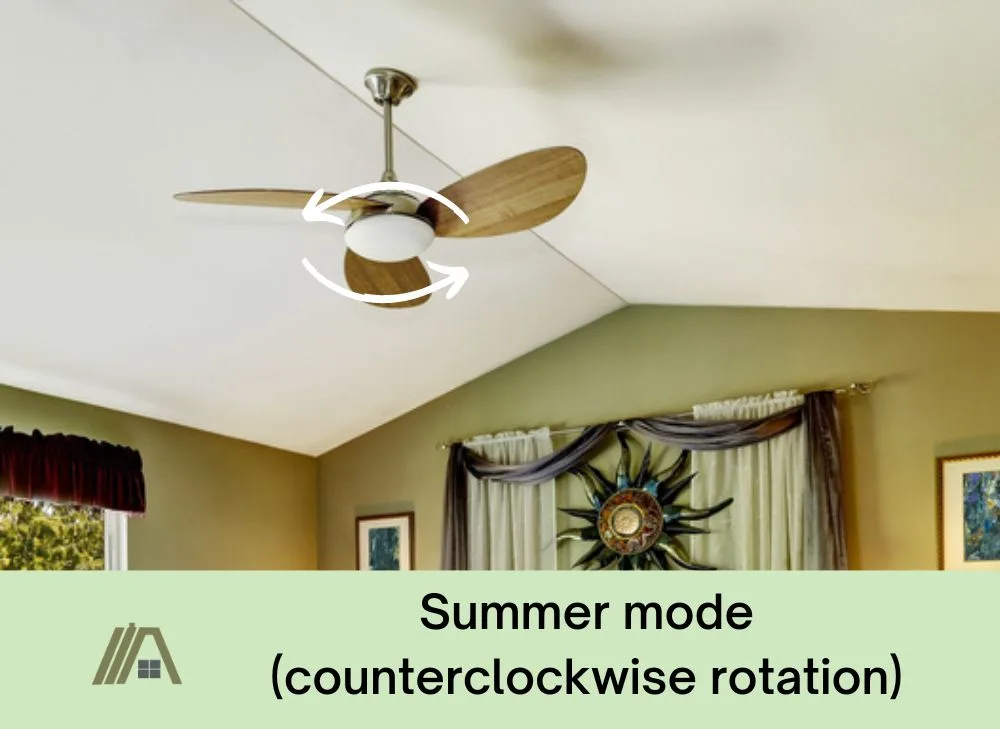Vaulted ceilings are no doubt a super trend that has made its way into many homes, adding height and texture to a space. However, the height of these ceilings changes the game a bit when it comes to installing ceiling fans.
Let’s look at if ceiling fans can be installed on vaulted/cathedral ceilings, if and/or why they are necessary, and their effectiveness in such locations.

Ceiling fans can work with vaulted/cathedral ceilings. They are beneficial in preventing stale air from gathering in the vertical space and to preventing heat loss to this space in winter. The fan will have to hang low enough to be effective, however, and will probably have to be oversized in terms of CFM.
Can Ceiling Fans Be Installed on Vaulted Ceilings?
Installing a ceiling fan on a vaulted ceiling is difficult but possible. In addition to all of the regular considerations, you will have a harder time obtaining the best clearances and physically installing the fan, particularly if the fan has to be installed on the sloping part of the ceiling.
Type of Fan Installation
You will not be able to use a flush mount or hugger fan. These will be too high for the air movements created by the ceiling fan to reach you. There is such a thing as too high when it comes to ceiling fan installation and flush mount fans are almost guaranteed to fall into this category with tall ceilings.
So, if you cannot use flush mounted fans, you are left with the standard downrod mounting option.
Sometimes, the normal downrod that comes with the fan will be sufficiently long for optimal or near-optimal placement. But because vaulted and cathedral ceilings are often around 13′ tall, you are likely to need an extender or extension rod.
Ceiling Fan Placement
The best placement for a ceiling fan in vaulted/cathedral ceilings is attached to the central horizontal beams that runs along the apex of the ceiling. This is because it is typically the most central location and it doesn’t require you to install the fan on a slope, which complicates things even more.

Even when installed along the apex, you have to consider the sloping portions of the ceiling. The fan has to hang low enough that the blades can have proper clearance from the ceiling, not hitting or brushing them, and far enough away that the airflow is not interfered with.
If you hang the fan on the sloped ceiling, you are more likely to benefit from the moving air because it will be easier to get the fan low enough for its effects to be felt. There are two major downsides to this, however:
- It is more difficult to install the fan here.
- It is unlikely to be centered in the room, which can create a displeasing aesthetic.
In asymmetrically vaulted ceilings, avoiding the slope is often impossible. So, what do you need for this type of installment?
You will need the correct length downrod to prevent the fan blades from sitting too close to the ceiling and you may need an adaptor (amazon link) that allows you to achieve the correct angle between the downrod and the joist. You can find more details in my article on installing fans on sloped ceilings.
Are Ceiling Fans Needed for High Ceilings?
Ceiling fans are great at establishing airflow throughout a room. When you have so much vertical height, windows and doors closer to the floor often don’t end up affecting the air above the ceiling sufficiently and it can become warm and stale, which reduces the indoor air quality.
Additional methods for circulating air in vaulted ceilings.
Furthermore, in winter, the height of vaulted or cathedral ceilings means that you are going to be losing a lot of the heat in the room to a space that you cannot occupy (unless you have an open plan loft).
This makes heating the room rather expensive and ineffective. Installing a ceiling fan can assist in keeping the warm air within the occupied regions of the room.
Now, the further the fan sits from the ceiling (beyond the optimal 18″), the less effective winter mode will be on the fan. This is because the fan pulls cold air up but it may not displace enough of the warm air above the fan because it’s too far away from this pocket of air.
Because ceiling fans need to be close enough to the floor in summer for you to benefit from the wind chill cooling mechanism, you often have to make a choice when it comes to ceiling fans on higher ceilings—do you want summer mode or winter mode to be effective?
Ceiling Fan Direction for Vaulted Ceilings
If you have to choose, I would recommend opting for summer mode (which is counterclockwise rotation) for two reasons:

- Winter mode is always going to be less effective than summer mode, even with a standard ceiling height.
- In summer mode, the fan can help to slow down the rise of warmer air in winter by countering the natural forces pulling the air up with mechanical forces pushing it back down. A slow speed setting will be needed here so that you don’t experience wind chill.
Should your ceiling be low enough for winter mode to still be effective under the right conditions, then make sure that you buy a fan with a remote that can control the direction of the fan.
If it only has a toggle switch on the fan assembly, you will have to pull out your ladder and your courage every time you want to switch the mode.
Energy Benefits of Ceiling Fans With High Ceilings
If you have a vaulted ceiling and you are trying to heat the space, then you are going to be spending a lot of money heating up the air around you, only to lose it a little while later to the unreachable space directly below the ceiling.
A ceiling fan in winter mode on slightly lower vaulted ceilings can counter this to a certain degree, as can a ceiling fan in summer mode on very high vaulted ceilings.
Are Ceiling Fans Effective Enough for High Ceilings?
All of the benefits of ceiling fans that we spoke about in the previous section rely on the ceiling fan producing sufficient air movement to reach the occupied space.
Not all ceiling fans will meet this requirement but there are certainly some that will and there are additional ways to increase the effectiveness of these fans:
- Go for the best blade design for optimal airflow.
- Oversize the fan for the space (larger fans produce stronger airflow, which can travel further).
Sources
https://www.delmarfans.com/educate/basics/how-to-calculate-the-slope-of-a-ceiling/
https://www.todaysfans.com/blogs/blog/what-is-cfm-in-a-ceiling-fan

